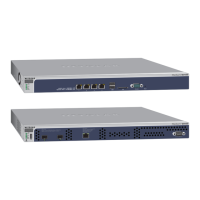Manage Security Profiles and Profile Groups
138
ProSAFE Wireless Controller
Shared Key 64-bit WEP
128-bit WEP
152-bit WEP
To configure Shared Key authentication with WEP:
1. From the Data Encryption menu, select a level of WEP
encryption:
- 64-bit WEP. Uses 40/64-bit encryption.
- 128-bit WEP. Uses 104/128-bit encryption.
- 152-bit WEP. A proprietary mode that works only with
other WiFi devices that support this mode.
2. To display the characters in the key fields, select the Show
Key check box.
3. Select a key radio button (Key1, Key2, Key3, or Key4).
4. Enter a key in the corresponding field:
- 64-bit WEP requires a key with 10 characters.
- 128-bit WEP requires a key with 26 characters.
- 152-bit WEP requires a key with 32 characters.
Note: For information about requirements for WEP keys, see
Table 15 on page 389.
Legacy 802.1x None To configure legacy 802.1x authentication:
1. Set up and enable an internal or external (RADIUS or LDAP)
authentication server.
For information, see Manage Authentication Servers and
Authentication Server Groups on page 140.
2. Select the Local or External radio button.
3. If you select the External radio button, select the
authentication server that you wish to use from the menu.
WPA with Radius TKIP
TKIP + AES
To configure WPA authentication with a RADIUS server:
1. Set up and enable an internal or external (RADIUS or LDAP)
authentication server.
For information, see Manage Authentication Servers and
Authentication Server Groups on page 140.
2. From the Data Encryption menu, select the type of
encryption:
- TKIP. Supports Temporal Key Integrity Protocol (TKIP)
only.
- TKIP + AES. Supports both TKIP and Advanced
Encryption Standard (AES).
3. Select the Local or External radio button.
4. If you select the External radio button, select the
authentication server that you wish to use from the menu.
Table 10. Network authentication and data encryption settings (continued)
Network Authentication
Selection
Data
Encryption
Options
Configuration Steps

